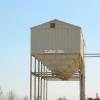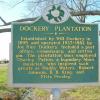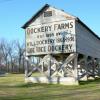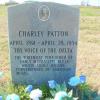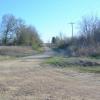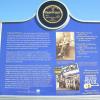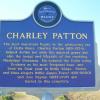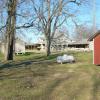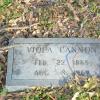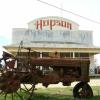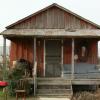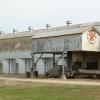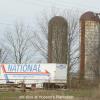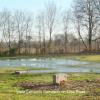While visiting the plantation, the Executive Director of the Dockery Farms Foundation, William Lester, arrived for a meeting. He took the time to share some of the history including an interesting story about Robert Johnson.
Reportedly, Johnson was visiting the plantation and became upset by derogatory comments made by his elder blues playing associates. He walked across the property to Lusk Road where the cemetery is located and continued to the crossroads of Old Highway 8. He returned to Dockery's shortly thereafter with his musical ability greatly enhanced.
The other story he shared was about Viola Cannon, Charley Patton's sister. He explained that Viola persuaded the Dockery Plantation owners that she should be entitled to Charley's gravesite, as he was not worthy because of his lifestyle.
Click thumbnail for a full size version!
The gravestone of Charley Patton is in a small cemetery next to a cotton gin in a remote area of Holly Ridge. We later learned that the body is not buried where the stone is located but rather in the ravine that separates the cemetery from the cotton gin.
Charley Patton, Holly Ridge, MS
Dockery Plantation, Cleveland, MS
This is where the Delta Blues was born
and where Charley Patton lived and worked for more than 30 years.
Will Dockery, a simple man, merchant and farmer, founded Dockery Plantation in 1895 and cleared the nearly 10,000 acre parcel for farming.
This is the most significant piece of real estate in all of blues history. Dockery's is to the blues what Jerusalem is to religion. Remarkably many of the original wooden structures are still standing.
Dockery's was a self contained, productive, bustling plantation with it's own physician, blacksmith, post office, commissary and saw mill. There was a Baptist church, a Methodist church and two elementary schools. The work force was comprised of 400 tenant families at it's peak in the early part of the twentieth century. The Patton family moved to Dockery's a few years after the plantation was founded. Working conditions and wages were better for tenants at Dockery's compared to other plantations in the area.
Passengers and supplies were taken to and from the plantation by either the rail line called the Peavine, an offshoot of the Yellow Dog, or by a steamboat which traversed the Sunflower River.
The interruptions in the work flow due to inclement weather or changes in the schedule provided the tenants with plenty of down time. This relieved them from the pressures of farming and inspired guitar playing as relaxation.
The most recognized crossroads however, is the intersection of Highway 49 and 61.
Viola Cannon, sister, who purportedly decided to have her brother's remains thrown in the ravine in Holly Ridge.
Lusk Road and Old Highway 8 "the real crossroads"
Charley learned guitar from a man named Henry Sloan who also lived at Dockery's. This plantation seemed to be a breeding ground for blues musicians and Charley was the center of the whole scene, a most celebrated musician. He would perform on Saturday nights at the commissary with other musicians, or in nearby towns like Ruleville and Drew.
Charley's incredible sense of rhythm, slide guitar playing, fingerpicking and larger than life vocals were simply unequaled amongst his peers. His foot stomping, riveting performances were always a big crowd pleaser. People would walk for miles to see him play.
He entertained the crowds with his acrobatic antics, playing the guitar behind his head and throwing it in the air, catching it on cue.
In 1929 Henry C. Speir, the renowned talent scout and music store owner, auditioned Charley at the suggestion of Bo Carter of the Mississippi Sheiks. He referred him to Paramount Records where Charley recorded for the first time in Richmond, Indiana. He did subsequent sessions for Paramount in Grafton, Wisconsin. In 1934 Charley recorded his last sessions for Vocalian in New York City. He died three months later.
Hopson Plantation was the first plantation to mechanize cotton picking in the early 1940's.This plantation was once home to "Pinetop Perkins."
A storage building, converted to a retail outlet called the "Juke Joint Chapel" offers items for sale including antiques, memorabilia, food, drink and weekly live entertainment.
Tenant sharecropper shacks which have been modernized with plumbing and A/C are available for rent. We stayed in the Robert Clay Shack. In the bathroom remains a copper coil, part of former tenant's whiskey still.
Hopson Plantation, Clarksdale, MS
The plantation had it's own cemetery called True Light. Any one who had been a tenant was entitled to a space in the cemetery.
The Green River Lumber Mill, near Lake Cormorant had a stream running through the property that became the inspiration for the song "Green River Blues" written by Charley Patton.
Delta Blues Journey
